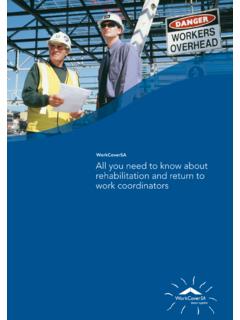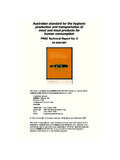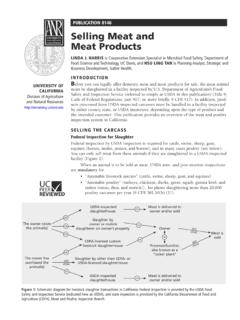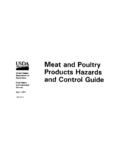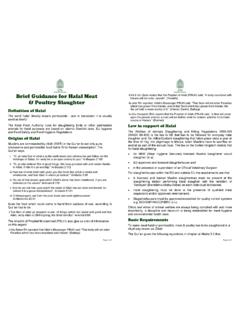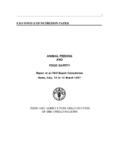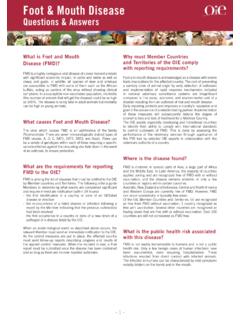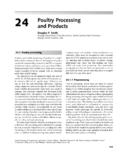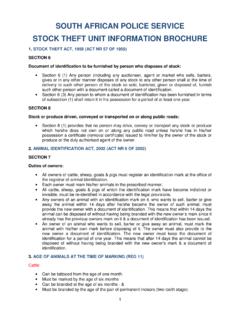Transcription of ANIMAL WELFARE STANDARDS - amic.org.au
1 LIVESTOCK PROCESSING ESTABLISHMENTSSECOND EDITION ReprintedPREPARING MEAT FOR human CONSUMPTIONINDUSTRYANIMAL WELFARE STANDARDSNATIONAL ANIMAL WELFARE STANDARDS FOR LIvESTOCk PROCESSING ESTAbLISHMENTS First edition (2005) prepared on behalf of the Australian Meat Industry Council (AMIC) and the Victorian Government s Naturally Victorian Initiative. Authored by M. K. Edge, T. Maguire, J. Dorian & in consultation with the National ANIMAL WELFARE STANDARDS for Livestock Processing Establishments Management Group. Published by Australian Meat Industry Council (AMIC).Second edition (2009) prepared on behalf of the Australian Meat Industry Council (AMIC). Authored by M. K. Edge in consultation with the National ANIMAL WELFARE STANDARDS for Livestock Processing Establishments Review Committee. Published by Meat & Livestock Australia (MLA) Meat Industry CouncilPO Box 1208 Crows Nest NSW 1585 General Inquiries: 02 9086 22003 INDUSTRY ANIMAL WELFARE STANDARDST able of contentsSECTION ONE INTRODUCTION 5 PREFACE 6 MISSION 6 PURPOSE 6 SCOPE 7 ROLES AND RESPONSIBILITIES 7 APPLICATION 8 EQUIVALENCE 8 SUMMARY OF THE STANDARDS 9 SECTION TWO THE STANDARDS 11 STANDARD 1: MANAGEMENT PROCEDURES AND PLANNING 12 STANDARD 2: DESIGN AND MAINTENANCE OF FACILITIES AND EQUIPMENT 13 STANDARD 3: STAFF COMPETENCY 14 STANDARD 4: MANAGEMENT AND HUMANE DESTRUCTION OF WEAK, ILL OR INJURED LIVESTOCK 15 STANDARD 5: MANAGEMENT OF LIVESTOCK TO MINIMISE STRESS AND INJURIES 16 STANDARD 6.
2 HUMANE SLAUGHTER PROCEDURES 17 SECTION THREE PERFORMANCE INDICATORS FOR IMPLEMENTATION- ON PLANT USE ONLY 19 SECTION FOUR AUDIT CHECKLIST FOR MONITORING PURPOSES 39 APPENDICES 51 APPENDIX 1: AUSTRALIAN STANDARD 52 APPENDIX 2: THE MANAGEMENT GROUP 53 APPENDIX 3: FLOW DIAGRAM OF ANIMAL WELFARE CONSIDERATIONS 54 APPENDIX 4: DEFINITIONS 55 APPENDIX 5: SIGNS OF SUCCESSFUL STUN 57 APPENDIX 6: STOCKING DENSITIES FOR LIVESTOCK IN LAIRAGE 58 APPENDIX 7: MONITORING PROCEDURES 59 ACKNOWLEDGEMENTS 63 INDUSTRY ANIMAL WELFARE STANDARDS4 AcronymsIn these STANDARDS , the following acronyms are detailed;AMICA ustralian Meat Industry Council CSIRO Commonwealth Scientific and Industrial Research Good Management Practice HACCP Hazard Analysis Critical Control Points MLAMeat and Livestock Australia OIE Office International des pizooties: World Organisation for ANIMAL HealthSCARM Standing Committee on Agriculture and Resource Management (Primary Industries Ministerial Council)SOPs Standard Operating Procedures WIWork Instructions 5 INDUSTRY ANIMAL WELFARE STANDARDSSECTION ONE INTRODUCTION INDUSTRY ANIMAL WELFARE STANDARDS6 PrefaceThese Industry ANIMAL WELFARE STANDARDS for Livestock Processing Establishments ( the STANDARDS ) were developed to help fulfil the expectations of both the Australian meat processing industry and the community of high levels of quality assurance for the management of livestock at Australian livestock processing establishments.
3 Livestock processing establishments already address issues associated with food safety and meat quality using quality assurance systems. The addition of ANIMAL WELFARE principles to these systems has provided a more comprehensive approach and assists industry to continually improve and demonstrate ANIMAL WELFARE outcomes. The STANDARDS are intended for incorporation into existing livestock processing industry quality assurance programs and to provide support towards demonstrating existing regulatory requirements in the industry. The STANDARDS provide information for all people responsible for the care and management of livestock at processing establishments. The STANDARDS include relevant provisions of the current Model Codes of Practice and the Australian STANDARDS and Guidelines for the WELFARE of Animals, together with targets and guidance from international and national guidelines and scientific evidence.
4 The STANDARDS also contain information to assist implementation, audit and STANDARDS were first developed in 2005 with the support of a national committee comprised of industry, science, policy, ANIMAL WELFARE , and other supply chain representatives. The STANDARDS were subsequently reviewed in 2009 (this edition) utilising a similar process. The Australian Meat Industry Council (AMIC) has committed to undertaking regular review of these livestock processing industry s mission is to ensure that high STANDARDS of ANIMAL WELFARE are implemented, maintained and verified. The livestock processing industry also aims to contribute towards continual improvement in ANIMAL WELFARE STANDARDS across the livestock supply chain. PurposeThese STANDARDS aim to: Clearly define ANIMAL WELFARE STANDARDS for incorporation into relevant industry quality assurance programs and Approved Arrangements.
5 Promote the humane and considerate treatment of livestock at processing establishments Provide information to support good husbandry and management practices that deliver good ANIMAL WELFARE outcomes. Define duty of care and associated responsibilities for people managing livestock at processing establishments. Provide assurance to customers and the general community that effective ANIMAL WELFARE STANDARDS for the livestock processing industry are in place and demonstrated to be met. Support the existing STANDARDS and guidelines relating to practices in the livestock processing industry including: AS 4696-2007 Australian Standard for the Hygienic Production and Transportation ofMeat and Meat Products for human consumption ( ). The Australian STANDARDS and Guidelines for the WELFARE of Animals, where these apply to the livestock processing industry.
6 Australian STANDARDS and Guidelines for the 7 INDUSTRY ANIMAL WELFARE STANDARDSW elfare of Animals as endorsed by the Primary Industry Ministerial Council replace the existing and relevant Codes of Practice for the WELFARE of Animals ( ). The Model Code of Practice for the WELFARE of Animals at Livestock Slaughtering Establishments. SCARM Report 79 ( ).- Provide consistency with international guidelines, including the OIE Terrestrial ANIMAL Health Code 2005: Guidelines for the Slaughter of Animals for human consumption . OIE World Organisation for ANIMAL Health ( ) Provide consistency with published commercial guidelines, for example the American Meat Institute Foundation s Good Management Practices for ANIMAL Handling and Stunning, 2005 Edition ( ).ScopeThe STANDARDS apply from the point of receival at the livestock processing establishment to the point of STANDARDS apply to the major commercially farmed species (excluding poultry) including cattle and calves, sheep, pigs, deer, goats, buffalo and horses.
7 These STANDARDS , however, contain general principles that can be applied to other species and livestock processing STANDARDS make a significant contribution to whole of chain (birth to slaughter) ANIMAL WELFARE outcomes when: There is a requirement for livestock processors to include provisions for ANIMAL WELFARE in their contractual arrangements with suppliers of product and services. There is a requirement for feedback from processors to suppliers on compliance with required ANIMAL WELFARE outcomes. There is a legal responsibility to notify relevant authorities of any instances of ANIMAL cruelty. Roles and responsibilitiesA large number of providers are involved in the delivery of services to livestock processing establishments. These include livestock producers, agents, transport operators, feed suppliers and personnel operating at depots, scales, saleyards and feedlots.
8 All have a responsibility to ensure that animals are handled and managed in accordance with Australian WELFARE requirements. This is best achieved through a combination of industry quality assurance systems and compliance with is the responsibility of livestock processing establishments to ensure that: livestock managers are aware of their legal and moral responsibility to care for the WELFARE of animals under their control; all personnel handling livestock are competent; procedures are in place to ensure all personnel on the premises conduct their activities to minimise risks to ANIMAL WELFARE ; feedback on adverse ANIMAL WELFARE outcomes is provided to suppliers and relevant regulatory authorities as required. Livestock processing establishments have a responsibility to ensure ANIMAL WELFARE outcomes are of a high standard.
9 This is achieved via incorporation of appropriate STANDARDS within the establishment s quality management system and/or Approved Arrangement which also includes: a demonstrated commitment by the proprietor to this objective; ANIMAL WELFARE considerations for daily management of livestock on the premises2; verification and review of all practices that impact on ANIMAL WELFARE ; 1 Appendix 3 defines the scope of these STANDARDS in further refer to of the Australian Standard for the Hygienic Production and Transportation of Meat and Meat Products for human ANIMAL WELFARE STANDARDS8 a requirement for feedback to suppliers (including transporters, feedlot personnel and farmers) on compliance with ANIMAL WELFARE is intended that these STANDARDS be incorporated into livestock processing quality management system(s) and/or Approved Arrangements.
10 The STANDARDS are presented in 3 sections:Section 1 of the STANDARDS defines the 6 STANDARDS , each with specific outcomes and principles which detail how the intended outcomes can be achieved. These STANDARDS and principles are the minimum requirements for ANIMAL 2 and 3 of this document provide good management practices, targets, and example audit checklists in support of the STANDARDS . It should be noted, however, that there may be other practices not described in this manual that can be applied to demonstrate the required outcomes of these 3 of the STANDARDS contains tabulated performance indicators which were developed for individual processing establishment implementation purposes. The performance indicator tables contain both targets and Good Management Practices (GMPs) to assist managers at processing establishments apply the STANDARDS in conjunction with other quality assurance section is designed to assist individual plant personnel work through their Approved Arrangements/Quality Assurance programs and identify the required practices in detail and note where the relevant information, work instructions, standard operating procedures and records for each Standard are located.
